One Piece Odyssey Review
Forgettable Odyssey
Best-selling manga One Piece isn’t short of game adaptations. In addition to sailing the Grand Line, the Straw Hat Pirates have navigated through several games ranging from fighting to adventure. Now it has anchored in a full-fledged role-playing game with One Piece Odyssey. The game spares no effort in trying to attract old and new fans alike, promising a new story written by Eiichiro Oda, One Piece’s legendary creator. However, One Piece Odyssey ends up playing it too safe. The whole thing is very predictable and uninspiring. Combat ages quickly, and exploration tires of itself, trading freedom for linearity right off the bat. It’s an experience that will likely only satisfy the biggest fans of the manga.
The game starts with a neat cutscene featuring the crew of the Straw Hat’s trademark talents. Each member flashes their skills against sharp, flying icicles, but soon are shipwrecked on an uncharted island. It’s up to the crew to unravel its mystery, fix their ship, and find Captain Luffy’s much-loved straw hat. In between, the colorful personalities of the characters are showcased as they explore the region. One Piece Odyssey makes no effort at properly introducing each pirate; fans of the series need no introduction. For those unfamiliar with the Straw Hats, only indifference is in store for them.
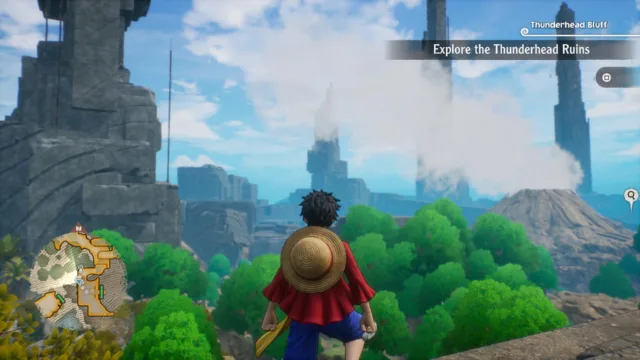
Most of the game’s scenarios are a sight for sore eyes.
Straight away, One Piece Odyssey introduces the player to the game’s unique characters, Lim and Adio. Both directly partake in the narrative, serving as key characters in its unfolding. Lim also acts as a conduit for non-fan players. After a basic tutorial and overview of Waford Island, One Piece Odyssey introduces the Memoria mechanic, which has the Straw Hats tackling previous arcs of the manga. This is where confusion will set in for newcomers, felling stuck playing a direct sequel without having experienced its predecessor. The narrative guide is Lim, whose job is to flood the crew with questions about the corresponding Memoria while also giving context to those unaware of these events. Still, it feels rushed and cropped, as if the game already expected players to be acquainted with it.
In the first Memoria, the game introduces a feature called Logs. They present a stunningly artistic retrospective of the arc. Like Lim, Logs help contextualize those new to One Piece. However, since this feature is optional, Logs can be easily overlooked, adding to the mess. Old fans might appreciate the flashback, as it acts as an interactive retrospective. These summaries become tedious to watch with the frequency they come up.
Between the Logs and visits to Memoria, the game is fueled by its turn-based battle system. One Piece Odyssey brings a few twists to the classic take on turn-based battles, allowing an extra dose of strategy with its rock-paper-scissors structure and zone-based battlefield dubbed the Scramble Battle Area system. Upon entering a fight, there’s the possibility that the four party members will be separated into zones, regardless of whether an enemy is present in it or not. Basic attacks and close-range abilities are reserved for enemies in the same zone, while long-range abilities can hit any opponent.
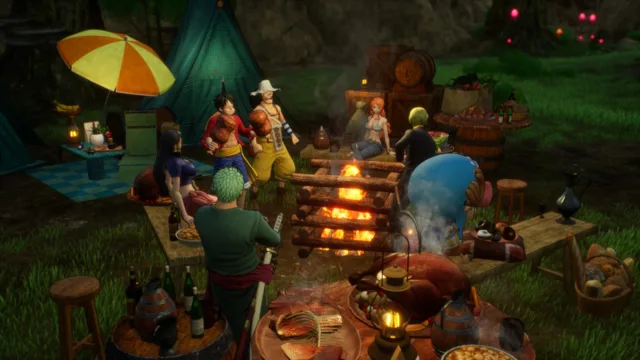
Parties heal the crew and provide buffs for subsequent battles.
Each unit in combat is one of three types: Power, Technique, or Speed. Power is strong against Speed; Speed beats Technique; Technique overpowers Power. If an ally is stuck with an enemy whose attack type is strong against their own, the situation thickens —or at least it should. Party members can be switched on the fly, either with the reserves or those currently in battle. Therefore, disadvantageous situations can easily be rectified, which undermines the strategy of the battle system. The player only needs to exchange the Straw Hat at the weak point with another one with an edge against the enemies in that zone, and that’s it; disadvantageous situation erased. Furthermore, battles are extremely easy to start with and there’s no way to increase difficulty. Several skills that strike the enemy’s weak point give a one-hit KO, discrediting any tactic.
To diversify, some battles feature dramatic scenes. These scenes grant bonuses to enemies, such as a temporary attack boost or the warning that they will unleash a powerful ability the next turn. The game then presents a requirement to resolve these dramatic scenes, such as killing the enemy with a specific character. If the player succeeds, they gain an extremely generous post-battle experience bonus. Dramatic scenes can involve using someone whose weakness is the enemy’s type, creating a risk-and-reward scenario. To counteract these situations, One Piece Odyssey has an equipment system called badges. Each character has a board, and each badge has a shape, like a Tetris piece. It’s up to the player to fit these badges, which provide bonuses in attributes or resistances. A straightforward crafting system creates buffing foods for the party, debuffing items for the enemies, and improves the badges. However, seasoned RPG players will quickly recognize the best build and break the game early on.
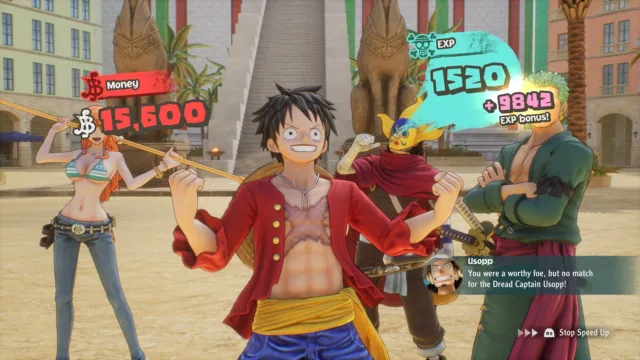
Fulfilling dramatic scenes is crucial to quickly level up characters.
On the artistic front, One Piece Odyssey leaves nothing to be desired. The graphics are vibrant, refined, and downright gorgeous. The special effects of each skill in battle are a treat. While the player can speed up the combat, they will at least watch each new set of skills acquired at the end of every chapter to appreciate their effects. The scenery is also lush, rich in detail and intricacy. Maps feature elements as far as the eye can see at a consistent and high framerate. The art direction, coupled with the soundtrack, makes One Piece Odyssey a delightfully visual feast. Each area, whether in the Memoria arcs or on Waford Island, features a stellar, joyful, and adventurous soundtrack. Even with constant interjections whenever a character uses their tasteless field skill, immersion is inevitable.
When it comes to exploration, the game stumbles. Straw Hats are the most landlubbin’ pirates ever, and players shouldn’t expect a ship voyage. In the first chapters, the game misleads, giving the impression that its areas are vast and rewardingly explorable. However, One Piece Odyssey soon becomes a primarily linear experience. The game features numerous optional content, such as bounty hunts; sidequests; Memory Links, which teach party members skills activated as pairs or trios; and treasure hunts. Sidequests are simple, sometimes humorous, but only engaging for those familiar with the cast. They also lack diligence and have a glaring problem of inconsistency. Lim watches the Straw Hats’ progress closely, commenting on how strange and alien their actions are compared to the pirate stereotype. Eventually, she forms an opinion about them throughout the main story. However, if players return to complete sidequests from previous chapters, Lim’s behavior will pertain to that chapter, ignoring all her character development. This creates a distracting inconsistency in the girl’s behavior.

The characters have different field skills. Zoro can slice down iron doors, and Chopper fits in small gaps.
Between the main story, traveling to old arcs, and completing optional content, One Piece Odyssey’s pacing is all over the place. The first half of the chapter list seems to make up 80% of the game, between meaningless back-and-forth fetching quests and filler cutscenes, while the other half runs over events and unravels mysteries in one sitting. The most awe-looking and exciting Memoria chapter concludes roughly thirty minutes in, wasting its tremendous potential, while an earlier chapter took its sweet time letting the player wander through a flat desert chasing after their stolen wallet or food. Odyssey is uninspiring; players know exactly what to expect at each chapter’s end, what strategy to employ in every battle, and even the narrative outcome.
One Piece Odyssey is a blatantly predictable and run-of-the-mill experience. While it may seem obvious that an anime game is targeted to an audience familiar with it, one may wonder why to waste an opportunity to make it more democratic and attract new fans. The tweaks to the classic turn-based battle structure are welcome but fall short due to the game’s unchallenging difficulty and easy-to-break equipment system. Die-hard One Piece fans will be able to appreciate the game as an interactive reminiscence of its arcs with minor redesigns. Yet, those looking for a bold and unique game may need to look elsewhere.
Disclosure: This review is based on a free copy of the game provided by the publisher.
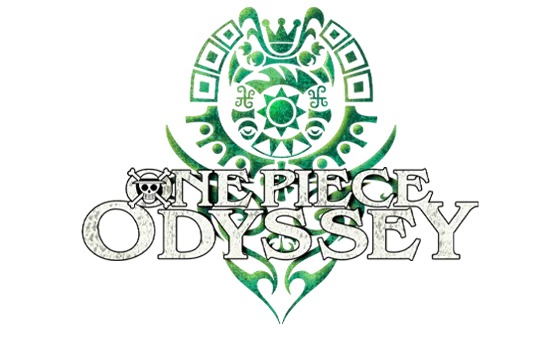

Beautiful and captivating world
Battle animations are exquisite
Dramatic scenes are ingenious
An uninspiring and predictable narrative
Dull exploration and side content
Combat is unchallenging and repetitious
Unwelcoming to players unfamiliar with One Piece
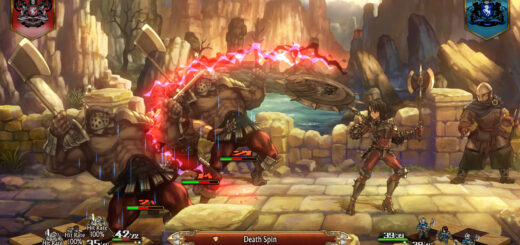





Recent Comments